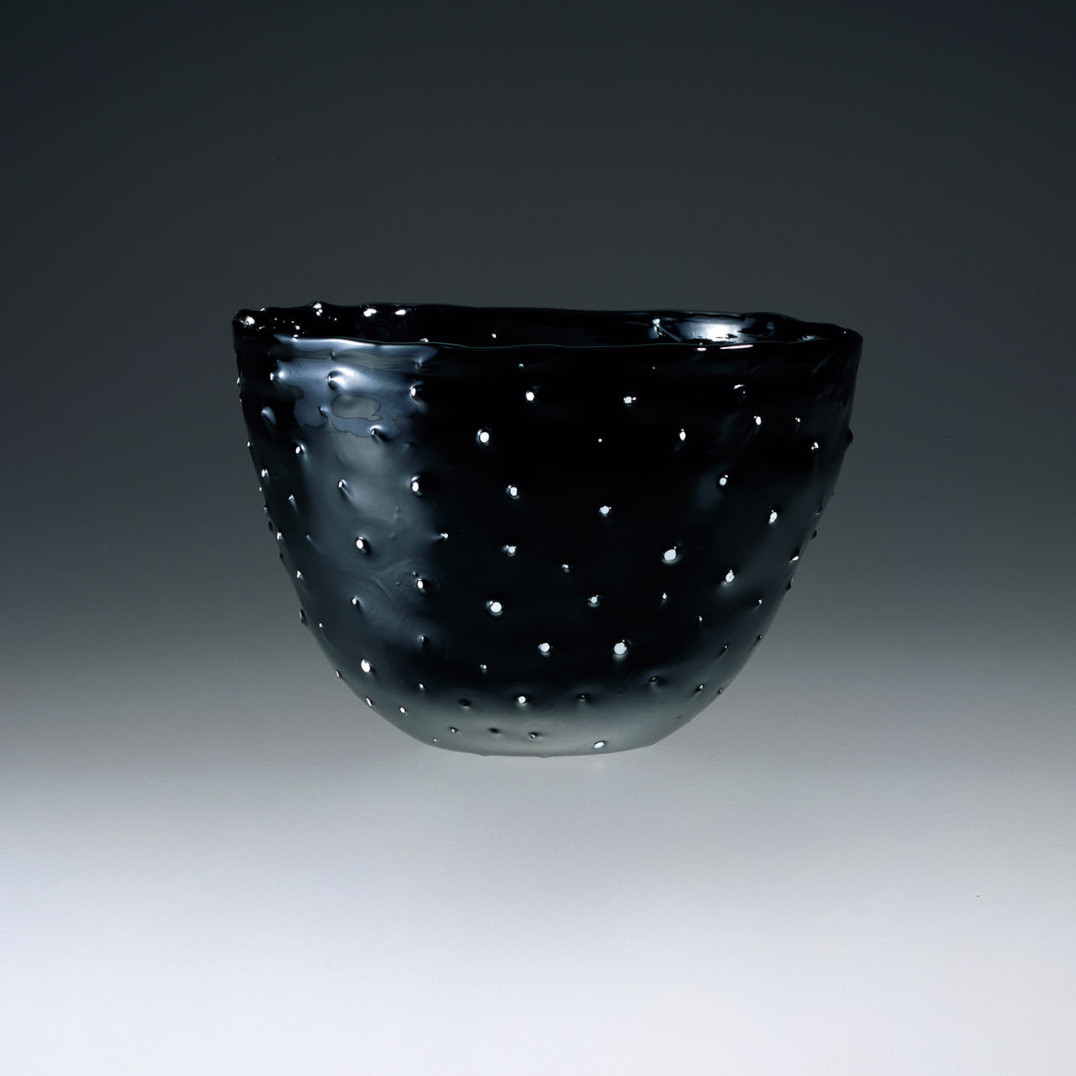
Carlo ScarpaGranulare, 1940
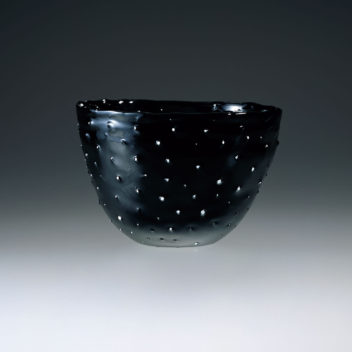
Carlo ScarpaGranulareVenini & C., 1940
A black bowl made of murrine with opaline core. The granular look was obtained by the difference in the cooling times of the black and the opaline glass: the opaline glass solidified first, thus remaining in
relief on the surface of the vessel.
Paper label: Venini n. 4116.
5 15/16 in. high (15.1 cm)
Ø; 8 3/4 in. (22.2 cm)
Exhibitions:
1940, Milan, 7th Triennale;
2000, New York, Venetian Glass, Museum of Arts & Design;
2001, Milan, Murano: Vetri dalla Collezione Olnick Spanu,
Spazio Oberdan.
Bibliography and comparative texts:
G. Ponti, 1940, p. 60;
F. Deboni, 1989, n. 64;
M. Barovier, 1991, n. 42;
L’arte del vetro…, 1992, p. 250;
A. Venini Diaz de Santillana, 1996, n. 96;
M. Barovier, 1997, p. 216;
A. Venini Diaz de Santillana, 2000, n. 132;
Olnick Spanu, 2000, n. 56;
Olnick Spanu, 2001, n. 88.
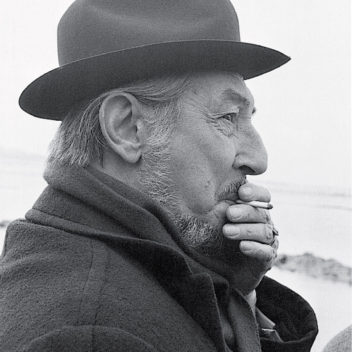
Carlo Scarpa 1906–1978
Born in Venice, Carlo Scarpa graduated from the Accademia di Belle Arti in Venice in 1926. Soon after his graduation he began work at M.V.M. Cappellin, where he soon replaced Vittorio Zecchin as artistic director. Following the direction laid down by Zecchin, he initially created transparent blown-glass pieces with essential forms, in particular the pieces exemplified by their conic base. Scarpa later designed light glass pieces in brightly colored pasta vitrea, or decorated fenici. Deservedly famous was the refined collection of lattimi decorated with gold or silver leaf, which he presented for the first time in Monza in 1930 together with the canne verticali and millefiori glass works. Giacomo Cappellin closed the workshop in 1932 for bankruptcy, putting an end to the collaboration with Carlo Scarpa. In 1934, Scarpa became the artistic director of Venini & C., where he continued to work through 1947. Alongside Paolo Venini, who often participated in the design of glass, Carlo Scarpa experimented with the vast potential of glass, using and innovating many traditional techniques, by which he created extraordinary modern pieces. After the mezza filigrana glass works came the sommersi, the pasta vitrea inspired by Chinese ceramic motifs, the corrosi, the battuti, the vessels a fasce colorate, a pennellate, the variegati, and the famous multicolored murrine with the surfaces finished at the carving wheel. After World War II, Carlo Scarpa worked almost exclusively as an architect and teacher.

Venini & C. 1932–2001
In 1932, when both Martinuzzi and Zecchin left the company, Paolo Venini changed the name from Vetri Soffiati Muranesi Venini & Co. (V.S.M. Venini & Co.) to Venini & C.. Milanese architect Tommaso Buzzi became the new artistic director. After 1934, artistic direction was taken on by Carlo Scarpa, who designed most of the company's production through 1947. Side by side with Venini, who often intervened personally in design, Scarpa created numerous collections of objects characterized by refined colors. After World War II, Venini & C. sought numerous collaborations with artists such as architect Giò Ponti and the Swedish-born Tyra Lundgren. After 1948, Fulvio Bianconi, Massimo Vignelli, and Tobia Scarpa contributed significantly to the new direction of the company. Paolo Venini died in 1959 and his son-in-law, Ludovico Diaz de Santillana, took over the management of Venini & C. He not only worked personally as a glass designer but also continued the collaboration started by Paolo Venini with various artists and designers. Starting in 1960, many other designers collaborated with the company, like Thomas Stearns, Toni Zuccheri, Tapio Wirkkala, Laura and Alessandro Diaz de Santillana, James Carpenter, Dan Dailey, Richard Marquis, Benjamin Moore, and Toots Zynsky. In 1986, the de Santillana family left the company, selling their stock to the Ferruzzi group, which guaranteed the fine quality Venini was known for by hiring new designers such as Timo Sarpaneva, Marco Zanini, Ettore Sottsass Jr., Alessandro Mendini, Mario Bellini, Barbara del Vicario, and others. In 1988, Venini was acquired by Royal Scandinavian. Since 2001, Venini S.p.A. has been part of Italian Luxury Industries Group and is led by Giancarlo Chimento, Giuliano Tabacchi, and Giorgio Rizzo.
Carlo ScarpaGranulare, 1940
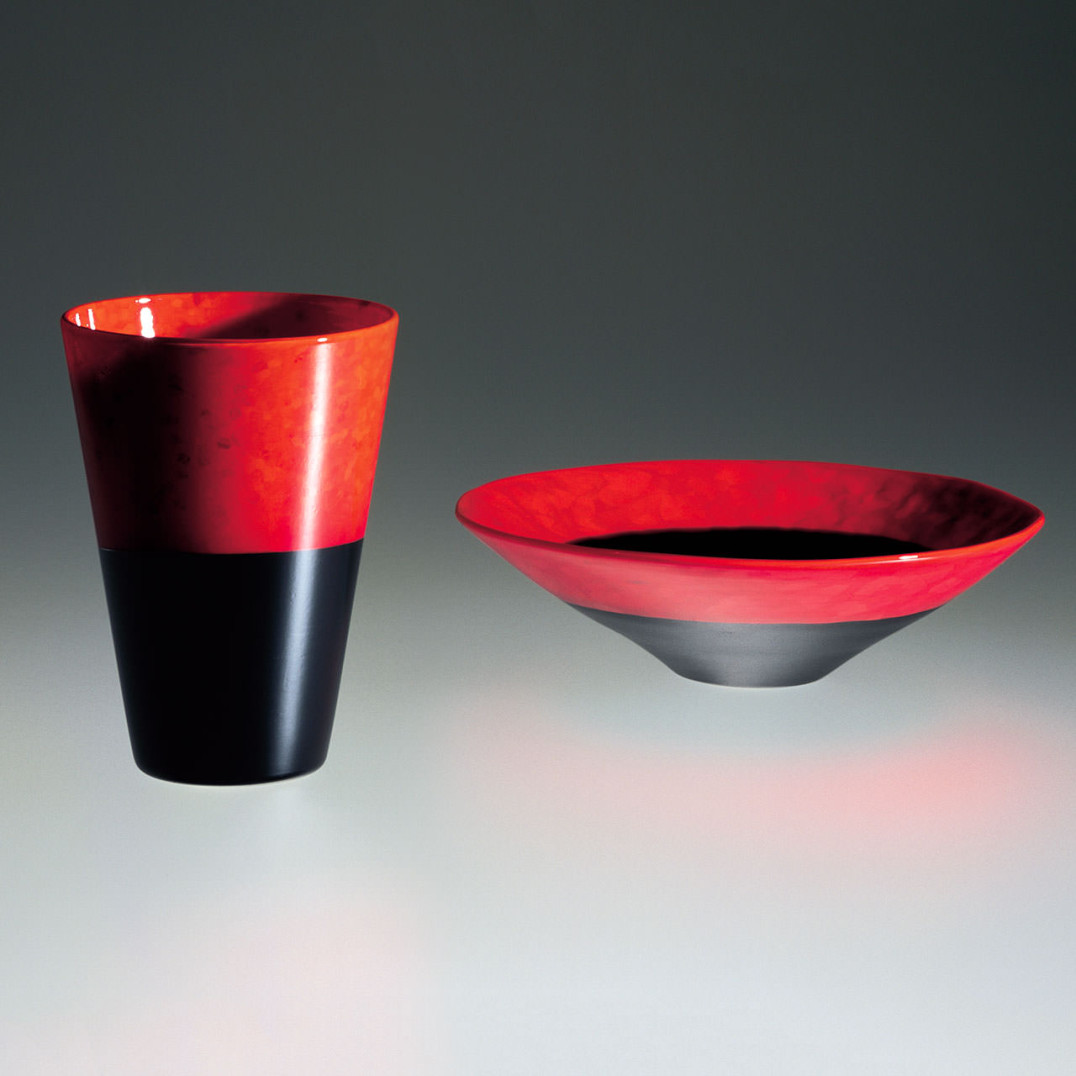
Carlo ScarpaLaccati rossi e neri, 1940

Carlo ScarpaLaccati rossi e neriVenini & C., 1940
Vase and bowl in black and red incalmo glass. In this series, the red glass was obtained by mixing small particles of prefinished glass into
the molten glass.
Acid stamped:
venini murano
MADE IN ITALY and venini murano ITALIA. Paper label.
6 7/8 in. high (17.5 cm)
2 3/4 in. high (7 cm)
Ø; 9 3/4 in. (24.7 cm)
Exhibitions and Bibliography
Exhibitions:
1940, Venice, 22nd Biennale Internazionale d’Arte;
2000, New York, Venetian Glass, Museum of Arts & Design;
2001, Milan, Murano: Vetri dalla Collezione Olnick Spanu,
Spazio Oberdan.
Bibliography and comparative texts:
Venini, blue catalogue, nn. 3611, 3601;
C.A. Felice, 1941, pp. 54, 55;
F. Deboni, 1989, pp. 24, 27;
L’arte del vetro…, 1992, p. 251;
M. Barovier, R. Barovier Mentasti,
A. Dorigato, 1995, n. 55;
F. Deboni, 1996, p. 75;
A. Venini Diaz de Santillana, 1996
n. 97; H. Ricke, E. Schmitt, 1996, n. 26;
M. Barovier, 1997, p. 216;
M. Barovier, 1998 (a), p. 27;
A. Venini Diaz de Santillana, 2000,
n. 141;
Olnick Spanu, 2000, n. 55;
Olnick Spanu, 2001, n. 87;
R. Losch, 2002, cover and n. 33

Carlo Scarpa 1906–1978
Born in Venice, Carlo Scarpa graduated from the Accademia di Belle Arti in Venice in 1926. Soon after his graduation he began work at M.V.M. Cappellin, where he soon replaced Vittorio Zecchin as artistic director. Following the direction laid down by Zecchin, he initially created transparent blown-glass pieces with essential forms, in particular the pieces exemplified by their conic base. Scarpa later designed light glass pieces in brightly colored pasta vitrea, or decorated fenici. Deservedly famous was the refined collection of lattimi decorated with gold or silver leaf, which he presented for the first time in Monza in 1930 together with the canne verticali and millefiori glass works. Giacomo Cappellin closed the workshop in 1932 for bankruptcy, putting an end to the collaboration with Carlo Scarpa. In 1934, Scarpa became the artistic director of Venini & C., where he continued to work through 1947. Alongside Paolo Venini, who often participated in the design of glass, Carlo Scarpa experimented with the vast potential of glass, using and innovating many traditional techniques, by which he created extraordinary modern pieces. After the mezza filigrana glass works came the sommersi, the pasta vitrea inspired by Chinese ceramic motifs, the corrosi, the battuti, the vessels a fasce colorate, a pennellate, the variegati, and the famous multicolored murrine with the surfaces finished at the carving wheel. After World War II, Carlo Scarpa worked almost exclusively as an architect and teacher.

Venini & C. 1932–2001
In 1932, when both Martinuzzi and Zecchin left the company, Paolo Venini changed the name from Vetri Soffiati Muranesi Venini & Co. (V.S.M. Venini & Co.) to Venini & C.. Milanese architect Tommaso Buzzi became the new artistic director. After 1934, artistic direction was taken on by Carlo Scarpa, who designed most of the company's production through 1947. Side by side with Venini, who often intervened personally in design, Scarpa created numerous collections of objects characterized by refined colors. After World War II, Venini & C. sought numerous collaborations with artists such as architect Giò Ponti and the Swedish-born Tyra Lundgren. After 1948, Fulvio Bianconi, Massimo Vignelli, and Tobia Scarpa contributed significantly to the new direction of the company. Paolo Venini died in 1959 and his son-in-law, Ludovico Diaz de Santillana, took over the management of Venini & C. He not only worked personally as a glass designer but also continued the collaboration started by Paolo Venini with various artists and designers. Starting in 1960, many other designers collaborated with the company, like Thomas Stearns, Toni Zuccheri, Tapio Wirkkala, Laura and Alessandro Diaz de Santillana, James Carpenter, Dan Dailey, Richard Marquis, Benjamin Moore, and Toots Zynsky. In 1986, the de Santillana family left the company, selling their stock to the Ferruzzi group, which guaranteed the fine quality Venini was known for by hiring new designers such as Timo Sarpaneva, Marco Zanini, Ettore Sottsass Jr., Alessandro Mendini, Mario Bellini, Barbara del Vicario, and others. In 1988, Venini was acquired by Royal Scandinavian. Since 2001, Venini S.p.A. has been part of Italian Luxury Industries Group and is led by Giancarlo Chimento, Giuliano Tabacchi, and Giorgio Rizzo.
Carlo ScarpaLaccati rossi e neri, 1940
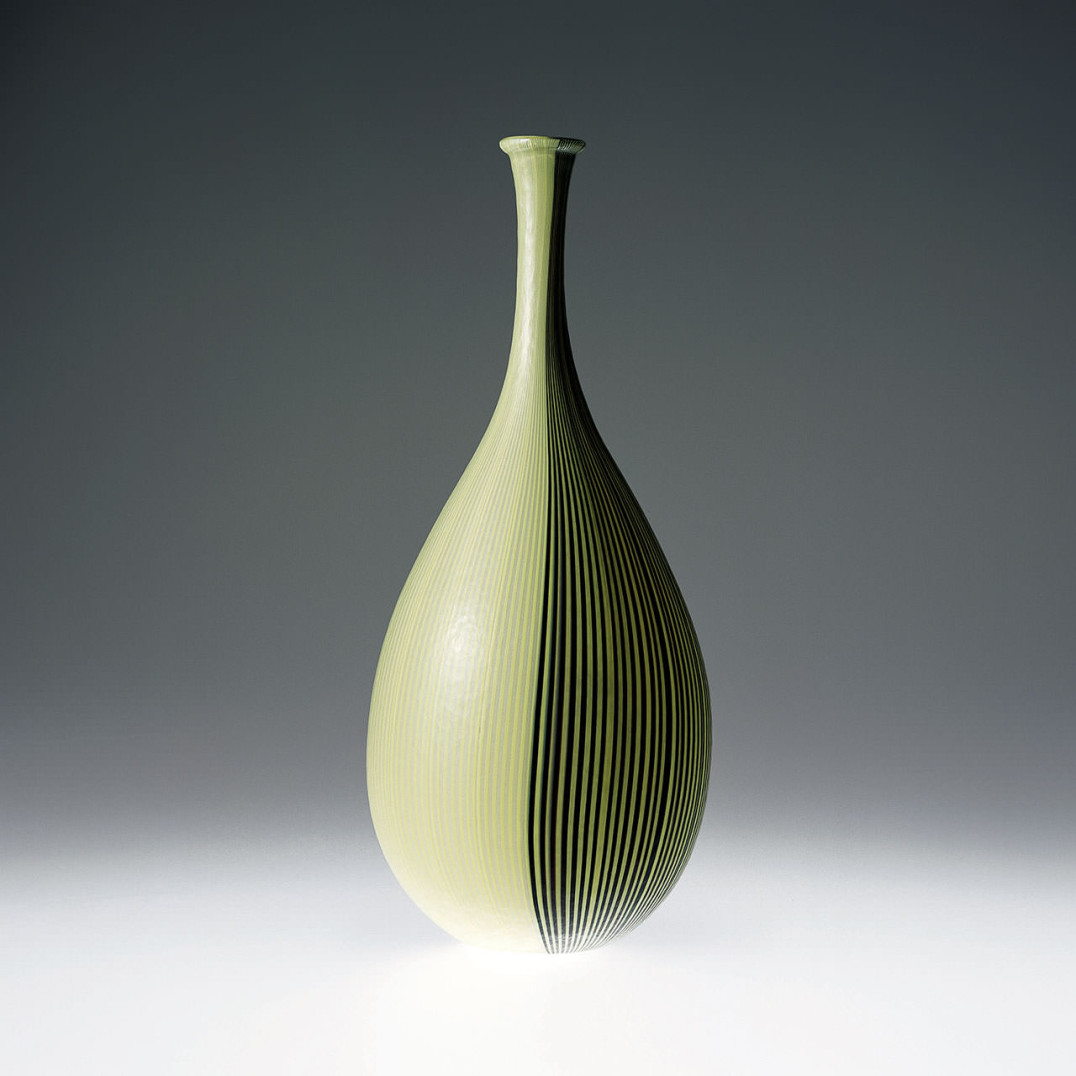
Carlo ScarpaTessuto, 1940
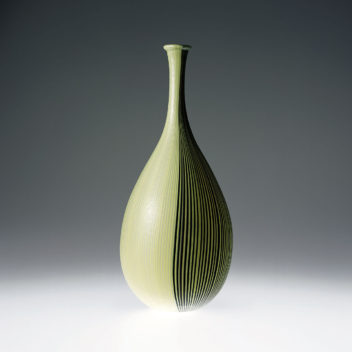
Carlo ScarpaTessutoVenini & C., 1940
A bicolored vessel with a velato finish. One half of the piece composed of thin vertical canes in amethyst and lattimo glass, the other half in yellow and lattimo glass.
Acid stamped:
venini murano
MADE IN ITALY.
13 1/4 in. high (33.6 cm)
Exhibitions:
1940, Venice, 22nd Biennale Internazionale d’Arte;
2000, New York, Venetian Glass, Museum of Arts & Design;
2001, Milan, Murano: Vetri dalla Collezione Olnick Spanu,
Spazio Oberdan.
Bibliography and comparative texts:
Venini, grey catalogue, n. 4550;
Olnick Spanu, 2000, n. 54;
Olnick Spanu, 2001, n. 86;
In addition, see description n. 84.

Carlo Scarpa 1906–1978
Born in Venice, Carlo Scarpa graduated from the Accademia di Belle Arti in Venice in 1926. Soon after his graduation he began work at M.V.M. Cappellin, where he soon replaced Vittorio Zecchin as artistic director. Following the direction laid down by Zecchin, he initially created transparent blown-glass pieces with essential forms, in particular the pieces exemplified by their conic base. Scarpa later designed light glass pieces in brightly colored pasta vitrea, or decorated fenici. Deservedly famous was the refined collection of lattimi decorated with gold or silver leaf, which he presented for the first time in Monza in 1930 together with the canne verticali and millefiori glass works. Giacomo Cappellin closed the workshop in 1932 for bankruptcy, putting an end to the collaboration with Carlo Scarpa. In 1934, Scarpa became the artistic director of Venini & C., where he continued to work through 1947. Alongside Paolo Venini, who often participated in the design of glass, Carlo Scarpa experimented with the vast potential of glass, using and innovating many traditional techniques, by which he created extraordinary modern pieces. After the mezza filigrana glass works came the sommersi, the pasta vitrea inspired by Chinese ceramic motifs, the corrosi, the battuti, the vessels a fasce colorate, a pennellate, the variegati, and the famous multicolored murrine with the surfaces finished at the carving wheel. After World War II, Carlo Scarpa worked almost exclusively as an architect and teacher.

Venini & C. 1932–2001
In 1932, when both Martinuzzi and Zecchin left the company, Paolo Venini changed the name from Vetri Soffiati Muranesi Venini & Co. (V.S.M. Venini & Co.) to Venini & C.. Milanese architect Tommaso Buzzi became the new artistic director. After 1934, artistic direction was taken on by Carlo Scarpa, who designed most of the company's production through 1947. Side by side with Venini, who often intervened personally in design, Scarpa created numerous collections of objects characterized by refined colors. After World War II, Venini & C. sought numerous collaborations with artists such as architect Giò Ponti and the Swedish-born Tyra Lundgren. After 1948, Fulvio Bianconi, Massimo Vignelli, and Tobia Scarpa contributed significantly to the new direction of the company. Paolo Venini died in 1959 and his son-in-law, Ludovico Diaz de Santillana, took over the management of Venini & C. He not only worked personally as a glass designer but also continued the collaboration started by Paolo Venini with various artists and designers. Starting in 1960, many other designers collaborated with the company, like Thomas Stearns, Toni Zuccheri, Tapio Wirkkala, Laura and Alessandro Diaz de Santillana, James Carpenter, Dan Dailey, Richard Marquis, Benjamin Moore, and Toots Zynsky. In 1986, the de Santillana family left the company, selling their stock to the Ferruzzi group, which guaranteed the fine quality Venini was known for by hiring new designers such as Timo Sarpaneva, Marco Zanini, Ettore Sottsass Jr., Alessandro Mendini, Mario Bellini, Barbara del Vicario, and others. In 1988, Venini was acquired by Royal Scandinavian. Since 2001, Venini S.p.A. has been part of Italian Luxury Industries Group and is led by Giancarlo Chimento, Giuliano Tabacchi, and Giorgio Rizzo.
Carlo ScarpaTessuto, 1940
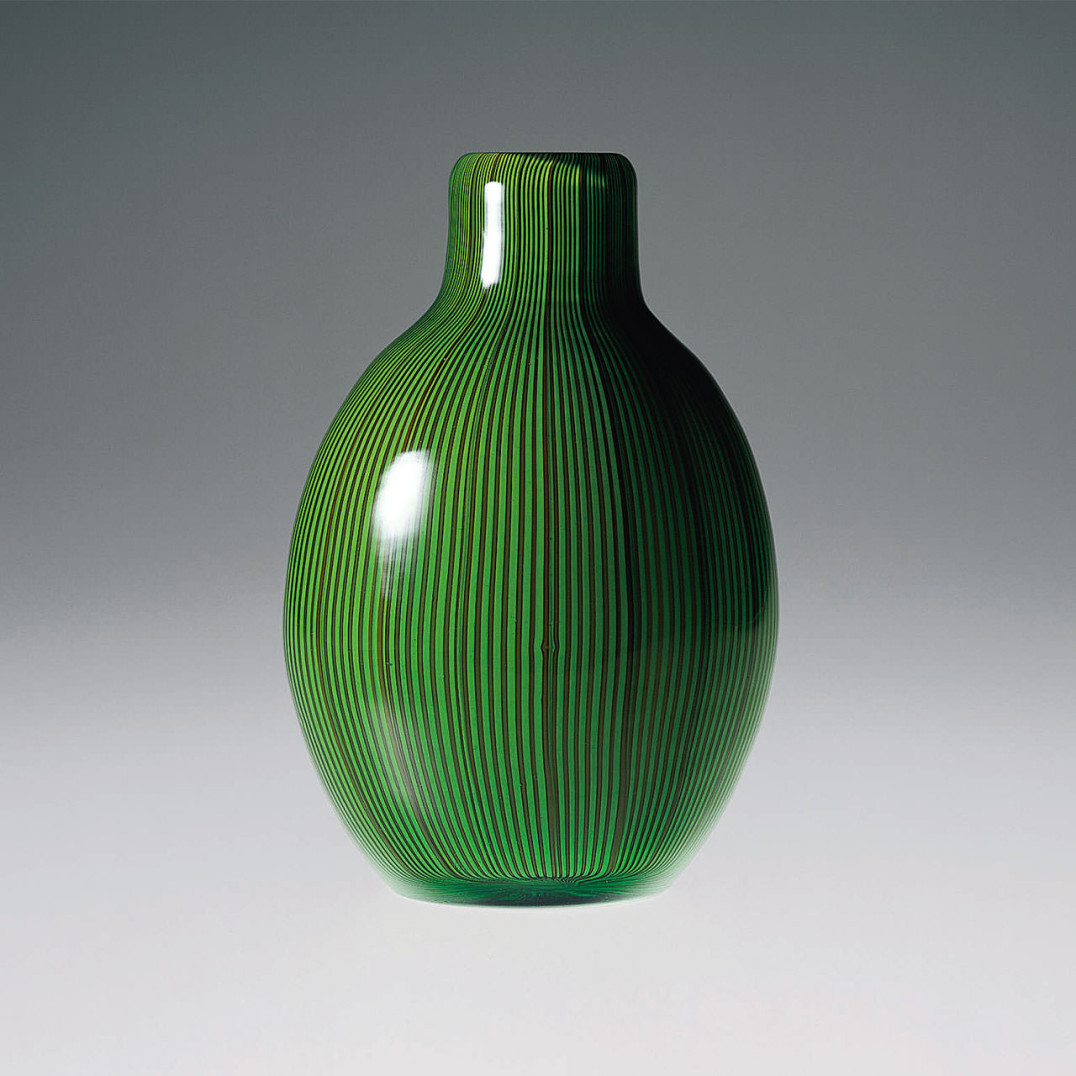
Carlo ScarpaTessuto, 1940
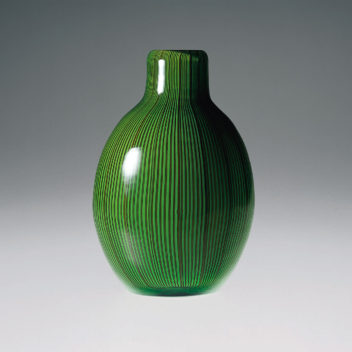
Carlo ScarpaTessutoVenini & C., 1940
A vase composed of thin vertical canes in green and amethyst, sommerso in cristallo glass.
Acid stamped:
venini murano.
8 1/4 in. high (21 cm)
Exhibitions:
2000, New York, Venetian Glass, Museum of Arts & Design;
2001, Milan, Murano: Vetri dalla Collezione Olnick Spanu,
Spazio Oberdan.
Bibliography and comparative texts:
Venini, blue catalogue, n. 3594;
Olnick Spanu, 2000, n. 53;
Olnick Spanu, 2001, n. 85;
In addition, see description n. 84.

Carlo Scarpa 1906–1978
Born in Venice, Carlo Scarpa graduated from the Accademia di Belle Arti in Venice in 1926. Soon after his graduation he began work at M.V.M. Cappellin, where he soon replaced Vittorio Zecchin as artistic director. Following the direction laid down by Zecchin, he initially created transparent blown-glass pieces with essential forms, in particular the pieces exemplified by their conic base. Scarpa later designed light glass pieces in brightly colored pasta vitrea, or decorated fenici. Deservedly famous was the refined collection of lattimi decorated with gold or silver leaf, which he presented for the first time in Monza in 1930 together with the canne verticali and millefiori glass works. Giacomo Cappellin closed the workshop in 1932 for bankruptcy, putting an end to the collaboration with Carlo Scarpa. In 1934, Scarpa became the artistic director of Venini & C., where he continued to work through 1947. Alongside Paolo Venini, who often participated in the design of glass, Carlo Scarpa experimented with the vast potential of glass, using and innovating many traditional techniques, by which he created extraordinary modern pieces. After the mezza filigrana glass works came the sommersi, the pasta vitrea inspired by Chinese ceramic motifs, the corrosi, the battuti, the vessels a fasce colorate, a pennellate, the variegati, and the famous multicolored murrine with the surfaces finished at the carving wheel. After World War II, Carlo Scarpa worked almost exclusively as an architect and teacher.

Venini & C. 1932–2001
In 1932, when both Martinuzzi and Zecchin left the company, Paolo Venini changed the name from Vetri Soffiati Muranesi Venini & Co. (V.S.M. Venini & Co.) to Venini & C.. Milanese architect Tommaso Buzzi became the new artistic director. After 1934, artistic direction was taken on by Carlo Scarpa, who designed most of the company's production through 1947. Side by side with Venini, who often intervened personally in design, Scarpa created numerous collections of objects characterized by refined colors. After World War II, Venini & C. sought numerous collaborations with artists such as architect Giò Ponti and the Swedish-born Tyra Lundgren. After 1948, Fulvio Bianconi, Massimo Vignelli, and Tobia Scarpa contributed significantly to the new direction of the company. Paolo Venini died in 1959 and his son-in-law, Ludovico Diaz de Santillana, took over the management of Venini & C. He not only worked personally as a glass designer but also continued the collaboration started by Paolo Venini with various artists and designers. Starting in 1960, many other designers collaborated with the company, like Thomas Stearns, Toni Zuccheri, Tapio Wirkkala, Laura and Alessandro Diaz de Santillana, James Carpenter, Dan Dailey, Richard Marquis, Benjamin Moore, and Toots Zynsky. In 1986, the de Santillana family left the company, selling their stock to the Ferruzzi group, which guaranteed the fine quality Venini was known for by hiring new designers such as Timo Sarpaneva, Marco Zanini, Ettore Sottsass Jr., Alessandro Mendini, Mario Bellini, Barbara del Vicario, and others. In 1988, Venini was acquired by Royal Scandinavian. Since 2001, Venini S.p.A. has been part of Italian Luxury Industries Group and is led by Giancarlo Chimento, Giuliano Tabacchi, and Giorgio Rizzo.
Carlo ScarpaTessuto, 1940
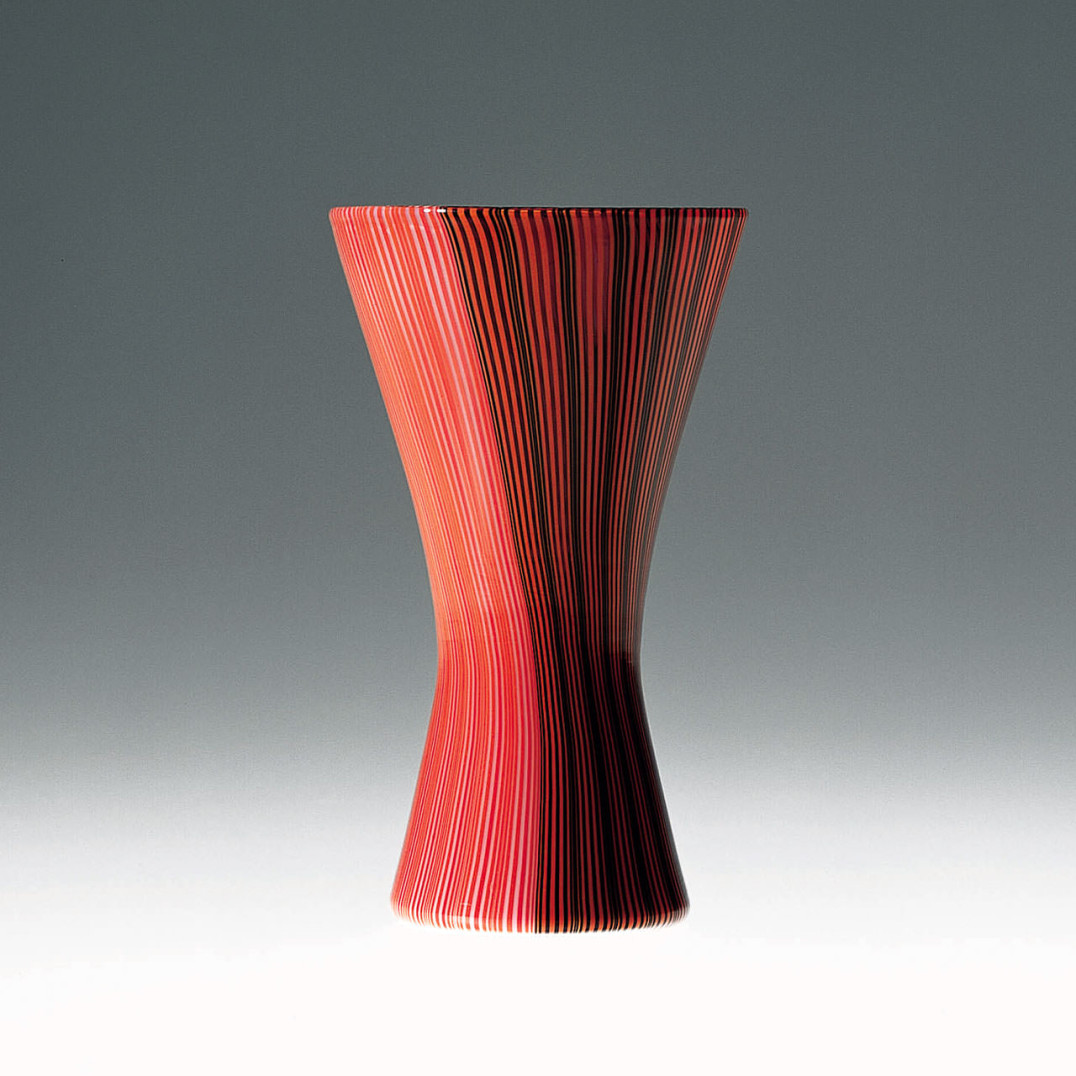
Carlo ScarpaTessuto, 1940
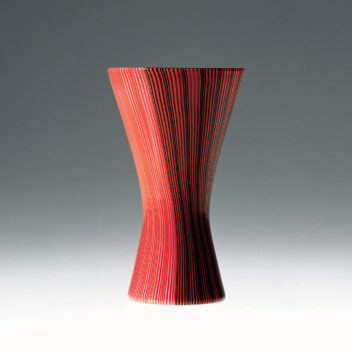
Carlo ScarpaTessutoVenini & C., 1940
A bicolored vase, one half composed of thin vertical canes
in red and black, the other half in
red and lattimo canes.
Acid stamped:
venini murano.
6 3/4 in. high (17.1 cm)
Exhibitions:
1940, Venice, 22nd Biennale Internazionale d’Arte;
2000, New York, Venetian Glass, Museum of Arts & Design;
2001, Milan, Murano: Vetri dalla Collezione Olnick Spanu,
Spazio Oberdan.
Bibliography and comparative texts:
G. Ponti, 1940, p. 70;
G. Mariacher, 1954, p. 169;
R. Aloi, 1955, p. 27;
G. Ponti, 1959, p. 40;
R. Barovier Mentasti, 1977, n. 67;
Venezianisches…, 1981, p. 68;
Mille anni…, 1982, n. 529;
Murano Glass…, 1982, n. 144;
R. Barovier Mentasti, 1982, p. 284;
M. Miani, D. Resini, F. Lamon, 1984, p. 84;
W. Neuwirth, 1987, p. 197;
F. Deboni, 1989, n. 68-70;
G. Duplani Tucci, 1989, nn. 17-18;
H. Ricke, 1990, p. 234;
M. Barovier, 1991, n. 38, 39;
L’arte del vetro…, 1992, p. 253;
M. Heiremans, 1993, n. 202;
M. Barovier, 1994, n. 12;
M. Barovier, R. Barovier Mentasti,
A. Dorigato, 1995, n. 58;
H. Ricke, 1995, p .236;
A. Venini Diaz de Santillana, 1996, nn. 114-116;
M. Heiremans, 1996, n. 65;
H. Ricke, E. Schmitt, 1996, nn. 39- 41;
M. Barovier, 1997, pp. 214, 215;
M. Barovier, 1998 (b), p. 25;
R. Barovier Mentasti, 1998, n. 90;
Venini Venezia, 1998, p. 67;
M. Barovier, 1999, p. 187;
Olnick Spanu, 2000, n. 52;
Olnick Spanu, 2001, n. 84.

Carlo Scarpa 1906–1978
Born in Venice, Carlo Scarpa graduated from the Accademia di Belle Arti in Venice in 1926. Soon after his graduation he began work at M.V.M. Cappellin, where he soon replaced Vittorio Zecchin as artistic director. Following the direction laid down by Zecchin, he initially created transparent blown-glass pieces with essential forms, in particular the pieces exemplified by their conic base. Scarpa later designed light glass pieces in brightly colored pasta vitrea, or decorated fenici. Deservedly famous was the refined collection of lattimi decorated with gold or silver leaf, which he presented for the first time in Monza in 1930 together with the canne verticali and millefiori glass works. Giacomo Cappellin closed the workshop in 1932 for bankruptcy, putting an end to the collaboration with Carlo Scarpa. In 1934, Scarpa became the artistic director of Venini & C., where he continued to work through 1947. Alongside Paolo Venini, who often participated in the design of glass, Carlo Scarpa experimented with the vast potential of glass, using and innovating many traditional techniques, by which he created extraordinary modern pieces. After the mezza filigrana glass works came the sommersi, the pasta vitrea inspired by Chinese ceramic motifs, the corrosi, the battuti, the vessels a fasce colorate, a pennellate, the variegati, and the famous multicolored murrine with the surfaces finished at the carving wheel. After World War II, Carlo Scarpa worked almost exclusively as an architect and teacher.

Venini & C. 1932–2001
In 1932, when both Martinuzzi and Zecchin left the company, Paolo Venini changed the name from Vetri Soffiati Muranesi Venini & Co. (V.S.M. Venini & Co.) to Venini & C.. Milanese architect Tommaso Buzzi became the new artistic director. After 1934, artistic direction was taken on by Carlo Scarpa, who designed most of the company's production through 1947. Side by side with Venini, who often intervened personally in design, Scarpa created numerous collections of objects characterized by refined colors. After World War II, Venini & C. sought numerous collaborations with artists such as architect Giò Ponti and the Swedish-born Tyra Lundgren. After 1948, Fulvio Bianconi, Massimo Vignelli, and Tobia Scarpa contributed significantly to the new direction of the company. Paolo Venini died in 1959 and his son-in-law, Ludovico Diaz de Santillana, took over the management of Venini & C. He not only worked personally as a glass designer but also continued the collaboration started by Paolo Venini with various artists and designers. Starting in 1960, many other designers collaborated with the company, like Thomas Stearns, Toni Zuccheri, Tapio Wirkkala, Laura and Alessandro Diaz de Santillana, James Carpenter, Dan Dailey, Richard Marquis, Benjamin Moore, and Toots Zynsky. In 1986, the de Santillana family left the company, selling their stock to the Ferruzzi group, which guaranteed the fine quality Venini was known for by hiring new designers such as Timo Sarpaneva, Marco Zanini, Ettore Sottsass Jr., Alessandro Mendini, Mario Bellini, Barbara del Vicario, and others. In 1988, Venini was acquired by Royal Scandinavian. Since 2001, Venini S.p.A. has been part of Italian Luxury Industries Group and is led by Giancarlo Chimento, Giuliano Tabacchi, and Giorgio Rizzo.